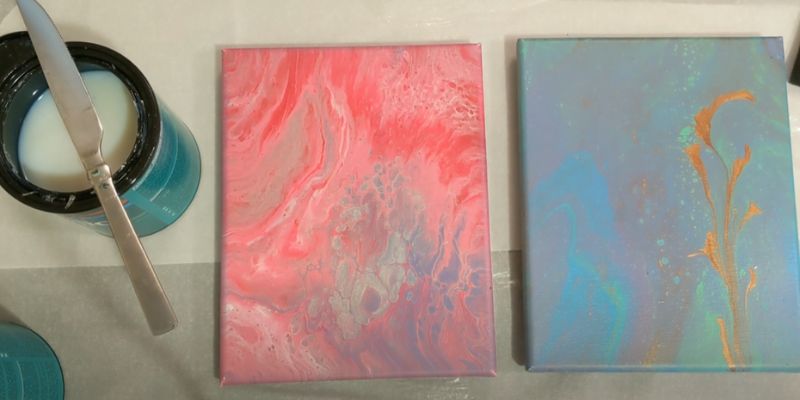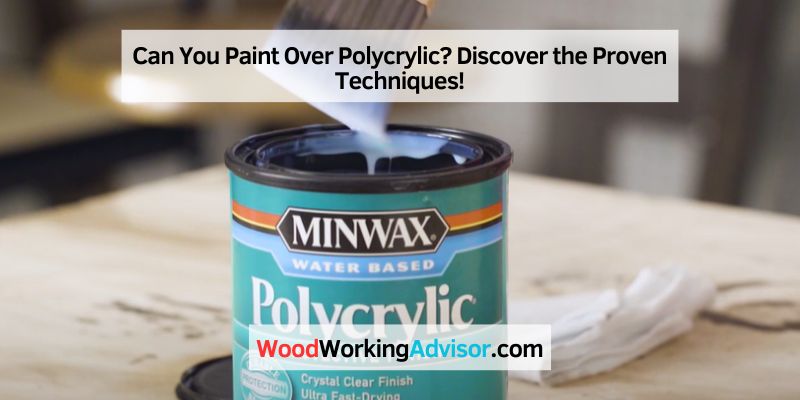Yes, you can paint over polycrylic without any issues. If you want to change the color or update the look of a surface that has been coated with polycrylic, painting over it is a simple and effective solution.
Preparing The Surface
Before you paint over polycrylic, it is crucial to prepare the surface properly. This will ensure that the new paint adheres well and provides a smooth and long-lasting finish. The preparation process involves two main steps: cleaning the surface and sanding the polycrylic. Follow these steps to get your surface ready for painting.
Cleaning The Surface
Start by cleaning the polycrylic-coated surface thoroughly. This step is essential to remove any dirt, dust, or grease that may be present. Cleaning will also eliminate any residues that could interfere with the adhesion of the new paint. Here’s how you can clean the surface effectively:
- Wipe the surface with a damp cloth to remove loose dirt and dust particles.
- Mix warm water with a mild detergent or dish soap.
- Gently scrub the surface with soapy water and a soft-bristle brush. Pay attention to any areas that have accumulated grime or sticky substances.
- Rinse the surface thoroughly with clean water to ensure that no soap residue remains.
- Dry the surface completely using a clean, lint-free cloth or allow it to air dry.
Sanding The Polycrylic
Sanding the polycrylic-coated surface is an essential step as it helps create a rougher texture for the new paint to adhere to. Follow these steps to sand the polycrylic effectively:
- Start by selecting the appropriate sandpaper grit. A fine-grit sandpaper, such as 220 grit, is usually suitable for this task.
- Wrap the sandpaper around a sanding block or use a sanding sponge for better control.
- Gently sand the polycrylic surface in circular or back-and-forth motions. Ensure that you cover the entire surface evenly, applying light pressure.
- Continue sanding until the polycrylic coating appears dull and slightly rough. Avoid sanding too aggressively, as it may damage the underlying surface.
- After sanding, wipe away any dust or residue using a clean, damp cloth.
By cleaning the surface and sanding the polycrylic, you have prepared the surface effectively for painting. The next step is to choose the right primer and paint for your specific project. With proper preparation, your painted surface will look flawless and withstand the test of time.

Choosing The Right Paint
Yes, you can paint over polycrylic. Using a high-quality primer will help the new paint adhere to the polycrylic surface. Make sure to lightly sand the surface before priming and painting to ensure proper adhesion and a smooth finish. Selecting the right paint and following the correct preparation steps will result in a successful paint job over polycrylic.
Understanding Latex Paint
Latex paint is a popular choice for many when it comes to painting over polycrylic. It is water-based and dries quickly, making it convenient for those who want to complete their painting projects in a shorter amount of time. Additionally, latex paint is easy to clean up with soap and water, which can be especially beneficial for beginners or those who are not as experienced in painting. It is also known for its durability and ability to resist cracking, which can extend the life of your painted surfaces.
Selecting Oil-based Paint
If you are looking for a more traditional option, oil-based paint may be the right choice for you when it comes to covering polycrylic. Oil-based paint is known for its smooth finish and excellent adhesion to various surfaces. It typically takes a longer time to dry compared to latex paint, allowing for more time to work with the paint and make any necessary adjustments. Oil-based paint is also known for its durability and resistance to wear and tear, making it a suitable option for high-traffic areas or surfaces that may be exposed to moisture.
Before you make a decision on which type of paint to use, consider the specific requirements of your project. If you want a quick-drying, easy-to-clean option, latex paint may be the way to go. On the other hand, if you prioritize a smooth finish and long-lasting results, oil-based paint may be more suitable. Remember to take into account factors such as the surface you are painting, the desired end result, and your personal preferences.
Applying The Paint
When applying paint over polycrylic, it’s important to follow the proper steps to ensure a smooth and long-lasting finish. The application process requires attention to detail and precision to achieve the desired results. Here are some important tips to consider when applying the paint over polycrylic:
Using A Quality Brush
One of the key factors in achieving a professional-looking paint job is using a quality brush. A high-quality brush will help distribute the paint evenly and smoothly, minimizing the appearance of brush strokes. Look for a brush specifically designed for the type of paint you’ll be using and ensure it’s clean and free from any debris that could mar the finish.
Applying Thin Coats
When painting over polycrylic, it’s crucial to apply the paint in thin, even coats. This helps prevent drips, runs, and uneven coverage. By applying multiple thin coats, you can build up the desired color and finish without the risk of creating a thick, uneven layer of paint. Be patient and allow each coat to dry completely before applying the next one.
Drying And Curing
Drying and curing are crucial steps when it comes to painting over polycrylic. These processes ensure the paint adheres properly to the surface, resulting in a durable and long-lasting finish. Adequate drying time allows the polycrylic to fully harden before applying paint, while proper curing ensures the paint bonds effectively with the polycrylic layer. Let’s delve into these steps in detail:
Allowing Sufficient Drying Time:
It is imperative to allow sufficient drying time for the polycrylic before applying paint. This ensures that the polycrylic layer has fully dried and hardened, providing a stable base for the paint to adhere to. The drying time may vary based on factors such as humidity, temperature, and the thickness of the polycrylic layer.
Here are a few key points to keep in mind:
- Check the manufacturer’s instructions for the recommended drying time for the specific polycrylic product you are using.
- Avoid rushing the drying process by attempting to paint over polycrylic that is not fully cured. This can lead to issues such as paint cracking or peeling.
- Ensure proper ventilation in the painting area, as it aids in the drying process.
Ensuring Proper Curing:
Proper curing is essential to ensure a strong bond between the polycrylic and paint layers. Curing allows the polycrylic to fully develop its hardness and chemical resistance. It is crucial to allow the polycrylic layer to cure before proceeding with the painting process. Here are some key considerations:
- Refer to the polycrylic manufacturer’s instructions for the recommended curing time. This can typically range from a few hours to a few days.
- Avoid subjecting the polycrylic layer to any harsh conditions or excessive moisture during the curing process, as this can compromise its performance.
- Ensure the curing process occurs in a controlled environment with moderate temperature and humidity levels.
By allowing sufficient drying time and ensuring proper curing, you create the ideal conditions for a successful paint job over polycrylic. Following these steps will contribute to a durable and visually appealing finish that enhances the longevity of your painted surfaces.

Credit: pinecarve.com
Finishing Touches
Polycrylic is a great protective coating for your surfaces, but can you paint over it? Yes, you can! With proper preparation, you can easily paint over polycrylic to give your project the perfect finishing touches.
Sanding Between Coats
One crucial step in achieving a flawless finish when painting over polycrylic is to sand between coats. Sanding helps create a smooth surface by removing any imperfections, bumps, or drips that may have occurred during the painting process. It also helps the subsequent coats of polycrylic adhere better, ensuring a more durable and long-lasting finish.
Applying A Protective Topcoat
Another important finishing touch is to apply a protective topcoat over the newly painted polycrylic surface. A protective topcoat not only adds an extra layer of protection but also enhances the overall appearance of the painted surface. There are various options available for a protective topcoat, including varnish, lacquer, or even another coat of polycrylic. These topcoats provide a protective barrier against scratches, UV damage, and moisture, ensuring that your painted surface remains vibrant and pristine for years to come.

Credit: pinecarve.com
Frequently Asked Questions Of Can You Paint Over Polycrylic
How Do You Paint Polycrylic?
To paint polycrylic, follow these steps:
1. Prep the surface by cleaning and sanding it.
2. Apply a primer if needed.
3. Use a brush or roller to apply the polycrylic in thin and even coats.
4. Allow each coat to dry before applying the next.
5. Sand lightly between coats for a smooth finish.
Is It Necessary To Sand Between Coats Of Polycrylic?
Yes, it is necessary to sand between coats of polycrylic to ensure a smooth and even finish. Sanding helps the next coat adhere better.
How Long Does Polycrylic Take To Cure?
Polycrylic typically takes about 2 hours to dry and 24 hours to fully cure.
Can You Paint Over Polyurethane?
Yes, you can paint over polyurethane. However, you need to prepare the surface by sanding it to promote better adhesion. Then, apply a primer designed for use on glossy surfaces before painting with your desired color.
Conclusion
Painting over Polycrylic is possible with proper preparation and the right technique. By following the steps outlined you can achieve a smooth and durable finish for your project. Remember to sand and prime the surface before applying the new coat of paint to ensure a successful outcome.


